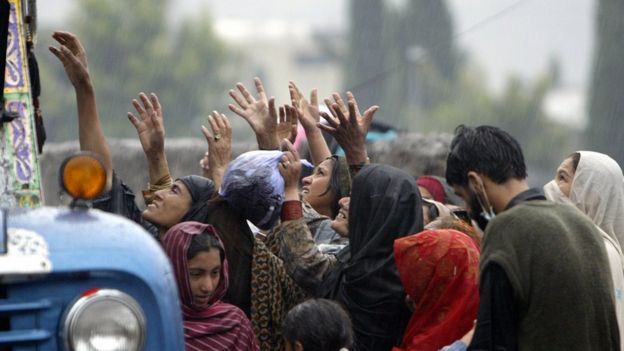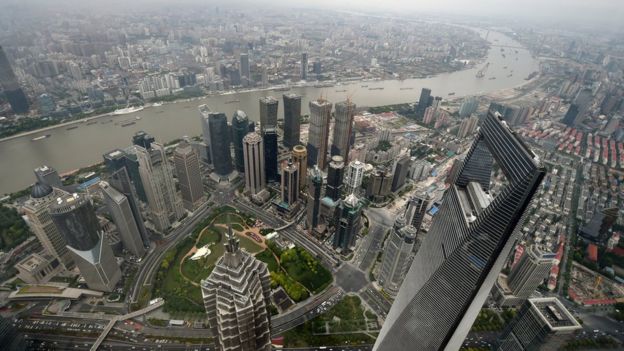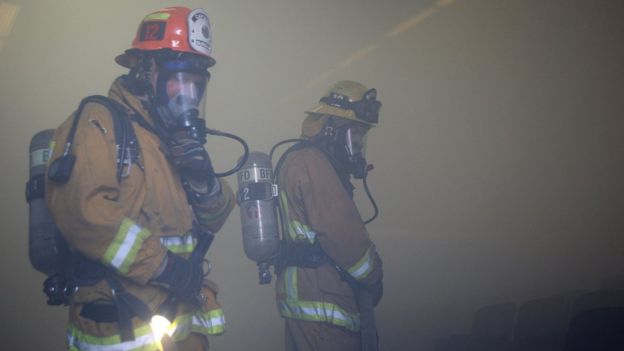Can you earthquake-proof a city?
- 24 March 2016
 Image copyright Reuters Image caption At least 11 people were killed when a 6.4 quake toppled buildings in Tainan, Taiwan in February
Image copyright Reuters Image caption At least 11 people were killed when a 6.4 quake toppled buildings in Tainan, Taiwan in February About a million people have died in earthquakes in the last two decades, most in a handful of huge quakes in urban areas.
Yet the population of cities at risk continues to grow.
Is such death and destruction inevitable?
Four experts talk to the BBC World Service Inquiry programme about how far we can quake-proof a city.
Dr Emily So: Lessons from the dead
Civil engineer Dr Emily So is director of Cambridge University's Centre for Risk and the Built Environment.
"Most deaths from earthquakes are caused by buildings collapsing: people are more likely to die in bad buildings.
"There are different types of buildings around the world, and with each of these the collapse mechanisms are different; dependent on roof types, the type of environment. For drier climates - in Peru for example - the roofing structure will be much lighter so that prevents death. Even though it collapses, the roof doesn't crush people.
"It's these kind of subtleties that I want to capture with my work.
 Image copyright Getty Images Image caption The 2005 Pakistan earthquake killed 86,000 people and left three million homeless
Image copyright Getty Images Image caption The 2005 Pakistan earthquake killed 86,000 people and left three million homeless "In 1999 there was an earthquake in Chichi in Taiwan which was 7.6 [on the Richter scale]. It killed just over 2,000 people. The same magnitude earthquake in Kashmir in Pakistan in 2005 killed over 86,000.
"I was watching news [of the 2005 Pakistani earthquake], and the frustration that we know how to build against building collapse and prevent these deaths was really the motivation behind the work I'm doing now.
"With a lot of developing countries like Pakistan, Nepal and Haiti, the population are keen to use modern materials like concrete, but they haven't got the skills or money to build them properly.
"They have the aesthetic of concrete, but not the actual material of an engineered reinforced concrete building, and therefore when the earthquake strikes, it becomes dead weight and falls on the people inside.
"Because of urbanisation, we are tending to build more and more in cities, and in more hazardous regions. Population density is making the issue more prominent.
"I think it is possible to earthquake-proof a city. We have the knowledge and the know-how to prevent collapse of buildings. We have the knowledge and know-how of where to put people because of research into seismology.
"But it comes down to awareness, the quality of the buildings, education, building control, economics and possibly political will as well, because these events don't happen very often, and priorities in different countries are different.
"There's a saying that for every $1 (£0.70) spent in mitigation, $7 (£4.90) is saved in relief and reconstruction, and that's the key message. Given that we know the hazard itself is not preventable, it's the vulnerability and exposure of the built environment and its inhabitants that we need to work on."
David Malott: High-tech city
Architect David Malott designed three of the world's ten tallest towers.
"Tall buildings are somewhat inherently more stable in an earthquake: the ground shakes, moving back and forth at something like half a second to two-and-a-half seconds. A building - depending on its height - will also have a natural frequency to it.
"When the ground shaking and the building swaying match up, they go into resonance and that's where we see these catastrophic results.
"Buildings in the low to mid-height range are inherently more susceptible to ground shaking, whereas a building which is 100 floors tall, ironically falls outside of that frequency of the earthquake and therefore doesn't go into resonance.
 Image copyright Getty Images Image caption The 492m-tall World Financial Centre in Shanghai (r) withstood the 2008 Sichuan earthquake
Image copyright Getty Images Image caption The 492m-tall World Financial Centre in Shanghai (r) withstood the 2008 Sichuan earthquake "I've been working on tall buildings for 15 years now. The first one I completed was the Shanghai World Financial Centre which is 492m tall.
"[When Shanghai shook during the Sichuan quake of 2008], it hardly moved. We have sensors on the building, and even during this earthquake, the tower moved something like a metre at its top.
"That's actually a very small amount of movement relative to the height of the tower. There's something to these towers being very flexible and able to sway gently, even though the forces of nature might be quite violent, that enables these structures to withstand what nature throws their way.
"There are a number of techniques to test whether a building is earthquake-proof. Computers play a large role in the early days. Engineers take historic data on past earthquakes and plug it into the computer model, and we watch the way the structure behaves in that earthquake, and the computer lets us know how big to make the columns, how thick a steel should we use.
"As the design gets more mature, in China for example, designers are required to build a large structural model. We put it on what's called the shaking table [which] rocks back and forth to simulate that earthquake environment, and then sensors are placed on the physical model and we watch how that model performs.
"This is expensive [but] these buildings are designed to last for 100 years, perhaps 200, so the investment you make in performing these tests is a drop in the bucket compared to the initial costs.
"The paradox is that the parts of the world where we're finding the greatest need for these tall towers in terms of just population density - places like China, Japan, Indonesia - are in the ring of fire, where we find the most difficulty in terms of earthquakes and typhoons. We're building in perhaps what's the most dangerous locations on earth, and that's the challenge."
Martijn Schildkamp: Low-tech approach
Architect Martijn Schildkamp founded a charity called Smart Shelter to strengthen cheap housing. He has built schools in Nepal using quake-resistant methods.
"Is it possible to earthquake-proof a city in the developing world? If you have a lot of money, yeah, but there's not a strong lobby behind it yet who can invest and do the testing, because the investment will never be returned.
"So there's still a lot of guess work. [When you drive through an area after an earthquake], you see houses which look like they've been built the same, but one is completely collapsed and the neighbour is still standing strong. Why? What's the difference here?
"We see stone, wood and bricks all over the world, so if you can figure out those basics and then have a little bit of tweaking on the local level, we can go a long way.
"One important element is the number of horizontal beams that hold the walls together. We call it 'tying up your building' like a present, and this combination of very simple techniques is what we train. Over and over again, repeating, repeating, supervising, supervising, but it really works.
Animated map: The Nepal earthquake and its 120 aftershocks
"Our buildings have been tested. Last year during the [Nepal] earthquakes, our buildings survived without a scratch. They were about 70km (43 miles) from the epicentre, so relatively close.
"In all fairness, the region where we are was not as severely hit as Kathmandu Valley, [but] I'm convinced that our schools would have done very well there as well.
"What I see now is that there's a lot of experimenting. In Nepal where people are building with sandbags and straw bales and plastic bottles, their justification is that it should be quick and cheap. I absolutely am against experimenting in the backyard of people that already lost their house once.
"It should be done in a safe environment in a university, where we first figure out exactly how it works before we consider building thousands of these at the same time in villages in Nepal. It just doesn't make sense.
"For Nepal, I see the benefit of building with gabion boxes - woven steel nets which we fill with stones. Rather than stacking them next to a mountain to prevent landslides, they say, 'No, let's stack them into walls,' because then we don't need cement which is very scarce and expensive there.
"We have two students working in Bologna in Italy to figure out if we can make those gabion boxes earthquake-resistant."
Dr Lucy Jones: Prioritise wisely
Dr Lucy Jones is science advisor for risk reduction at the US Geological Survey.
"Stopping all earthquake damage is an insanely expensive process. Stopping enough that you can keep your society functioning, that's very doable if you're willing to put in time and effort.
"What you need to do is prioritise. There's only so much money that's available. There's only so much political capital that's available, and being wise about which ones you tackle is critical.
"I had the opportunity within the US Geological Survey to create a project to demonstrate how we could use hazard science to improve a community's resilience to natural disasters.
"We created a model of what a magnitude 7.8 San Andreas earthquake would be like, and said 'let's use the media, use the attention to get people to focus on what we know about the big earthquake and motivate some political action'.
 Image copyright Getty Images Image caption In the simulation, 1,800 people died, 53,000 were injured and 1,500 buildings collapsed
Image copyright Getty Images Image caption In the simulation, 1,800 people died, 53,000 were injured and 1,500 buildings collapsed "We ended up getting 5.5 million people to participate in the drill, which is a quarter of the population of Southern California.
"The good news is we've gotten traction. Los Angeles Mayor Eric Garcetti turned out to be a very visionary guy who listened to what we had to say, and committed to doing something about it. The Resilience by Design programme that I helped him develop is moving forward.
"There is a style of construction that was popular in the 1950s and 1960s called non-ductile reinforced concrete. There are 1500 of those buildings in Los Angeles and thousands more in the region.
"Probably 10-20% of them would collapse under strong shaking, and their concrete is heavy, so the largest number of fatalities are expected to occur in those buildings.
"We're mandating retrofit. We're talking about billions of dollars having to be spent on existing buildings, and we were able to talk the business community into supporting this. We passed unanimously in the city council. Nobody objected, because they can see their investment is at stake.
"So there are a lot of very positive things that are growing, and if we can just hold the earthquake off for long enough, I think we can turn it around.
"I don't think I'm going to earthquake-proof Southern California, but I really do think that we can get enough pieces in place that we can keep her going."
The Inquiry is broadcast on the BBC World Service on Tuesdays from 12:05 GMT. Listen online or download the podcast.
--
__._,_.___

No comments:
Post a Comment